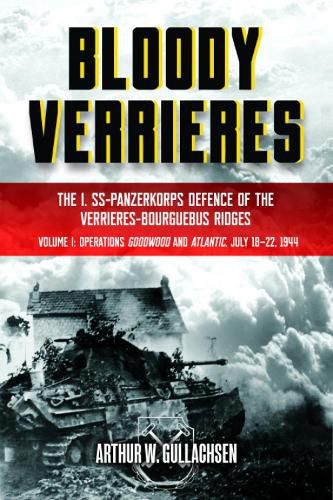Readings Newsletter
Become a Readings Member to make your shopping experience even easier.
Sign in or sign up for free!
You’re not far away from qualifying for FREE standard shipping within Australia
You’ve qualified for FREE standard shipping within Australia
The cart is loading…






This book follows the I. SS Panzerkorps as they meet with the Anglo-Canadian forces in the area of the Verrieres and Bourguebus ridges. South of the Norman city of Caen, the twin features of the Verrieres and Bourguebus ridges were key stepping stones for the British Second Army in late July 1944 - taking them was crucial if it was to be successful in its attempt to break out of the Normandy bridgehead. To capture this vital ground, Allied forces would have to defeat arguably the strongest German armoured formation in Normandy: the I. SS-Panzerkorps Leibstandarte. The resulting battles of late July and early August 1944 saw powerful German defensive counterattacks south of Caen inflict tremendous casualties, regain lost ground and at times defeat Anglo-Canadian operations in detail. Viewed by the German leadership as militarily critical, the majority of its armored assets were deployed to dominate this excellent tank country east of the Orne river. These defeats and the experience of meeting an enemy with near-equal resources exposed a flawed Anglo-Canadian offensive tactical doctrine that was overly dependent on the supremacy of its artillery forces. Furthermore, weaknesses in Allied tank technology inhibited their armored forces from fighting a decisive armored battle, forcing Anglo-Canadian infantry and artillery forces to further rely on First World War Bite and Hold tactics, massively supported by artillery. Confronted with the full force of the Panzerwaffe, Anglo-Canadian doctrine at times floundered. In response, the Royal Artillery and Royal Canadian Artillery units pummelled the German tankers and grenadiers, but despite their best efforts, ground could not be captured by concentrated artillery fire alone. This is a detailed account of the success of I. SS-Panzerkorps’ defensive operations, aimed at holding the Verrieres-Bourgebus ridges in late July 1944. AUTHOR: Arthur W. Gullachsen teaches at the Royal Military College of Canada in Kingston, Ontario as an Assistant Professor in the History Department. He is an alumni of the University of Western Ontario and graduated with a PhD in history in 2016. He has published articles online on the Canadian Army with the Canadian Military History Journal and has provided professional development material for the U.S. Army on the Normandy campaign. He has previously published An Army of Never-Ending Strength: Reinforcing the Canadian Army in North-West Europe 1944 1945.
$9.00 standard shipping within Australia
FREE standard shipping within Australia for orders over $100.00
Express & International shipping calculated at checkout
This book follows the I. SS Panzerkorps as they meet with the Anglo-Canadian forces in the area of the Verrieres and Bourguebus ridges. South of the Norman city of Caen, the twin features of the Verrieres and Bourguebus ridges were key stepping stones for the British Second Army in late July 1944 - taking them was crucial if it was to be successful in its attempt to break out of the Normandy bridgehead. To capture this vital ground, Allied forces would have to defeat arguably the strongest German armoured formation in Normandy: the I. SS-Panzerkorps Leibstandarte. The resulting battles of late July and early August 1944 saw powerful German defensive counterattacks south of Caen inflict tremendous casualties, regain lost ground and at times defeat Anglo-Canadian operations in detail. Viewed by the German leadership as militarily critical, the majority of its armored assets were deployed to dominate this excellent tank country east of the Orne river. These defeats and the experience of meeting an enemy with near-equal resources exposed a flawed Anglo-Canadian offensive tactical doctrine that was overly dependent on the supremacy of its artillery forces. Furthermore, weaknesses in Allied tank technology inhibited their armored forces from fighting a decisive armored battle, forcing Anglo-Canadian infantry and artillery forces to further rely on First World War Bite and Hold tactics, massively supported by artillery. Confronted with the full force of the Panzerwaffe, Anglo-Canadian doctrine at times floundered. In response, the Royal Artillery and Royal Canadian Artillery units pummelled the German tankers and grenadiers, but despite their best efforts, ground could not be captured by concentrated artillery fire alone. This is a detailed account of the success of I. SS-Panzerkorps’ defensive operations, aimed at holding the Verrieres-Bourgebus ridges in late July 1944. AUTHOR: Arthur W. Gullachsen teaches at the Royal Military College of Canada in Kingston, Ontario as an Assistant Professor in the History Department. He is an alumni of the University of Western Ontario and graduated with a PhD in history in 2016. He has published articles online on the Canadian Army with the Canadian Military History Journal and has provided professional development material for the U.S. Army on the Normandy campaign. He has previously published An Army of Never-Ending Strength: Reinforcing the Canadian Army in North-West Europe 1944 1945.